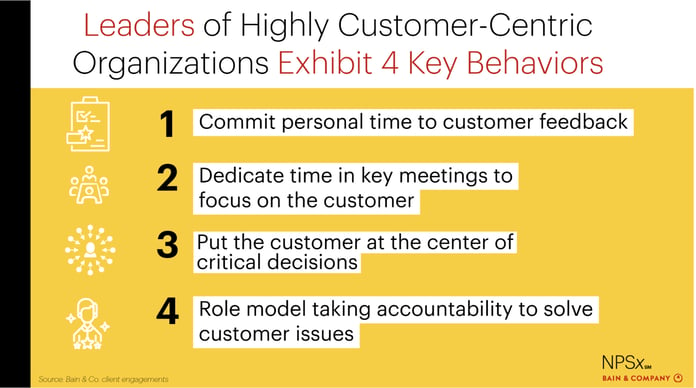
Featuring insights from Phil Sager, Expert Partner at Bain & Company.
The benefits of customer centricity can be seen in everything from improved customer loyalty to increased market share and greater profitability. Leaders at all levels and across all functions of customer-centric organizations know that to realize long-term success, customers must be front and center at all times.
But what behaviors do effective leaders embrace to drive a customer-centric approach across their business?
We explored this topic with Phil Sager and Tracey Thurkow during our NPSx Webinar (details & link below) on Leadership Behaviors for Success in Customer Experience (CX). Below is the short-list of four key behaviors most commonly observed at companies who win with a focus on customer:
1. They commit personal time to customer feedback
Leaders understand the importance of engaging directly with customer feedback and commit precious time to review the comments from both detractors and promoters. They avoid the temptation of fully delegating this to others or relying on aggregate metrics and scores that remove the emotion from feedback.
This can show customers that their opinions are valued and respected, which helps build trust and brand loyalty. It also allows leaders to understand how customers feel about their products and services and make changes as needed. Additionally, when executives invest personal time into customer feedback, they can more easily spot emerging trends or issues before they become bigger problems. Most importantly, it sets an example for the organization that time spent on customer feedback is highly valued.
2. They dedicate time in key meetings to focus on the customer
The agenda topics in key meetings (like board meetings, executive strategy debates, town halls and budget discussions) telegraph the organization’s priorities to all employees and stakeholders. Prioritizing time in these valuable forums to focus on the customer make it clear that enriching customer lives is a central focus for the leaders and the company. Customer stories, and in some cases live customer participation, shape the conversation and demonstrate customer focus.
3. They put the customer at the center of critical decisions
Your customer experience is the result of the decisions your leaders make – both big strategic ones and the myriad of day-to-day decisions. If the customer is not part of the decision criteria, then you might unintentionally erode trust and loyalty. You might also create confusion for employees, “when do I consider the customer impact and when do I not?” Customer needs are always better met in the long run by healthy, thriving organizations with the capacity to innovate and be there for customers in the future. Placing the customer at the center of critical decisions does not imply giving customers everything they request; it means considering the implications and making intentional choices to act in the customer’s best interest.
4. They role model taking accountability to solve customer issues
“Walk the walk” [sic] is a common refrain in the study of great leaders. Effective leaders set an example for their teams by taking ownership for resolving customer issues efficiently. To avoid dis-empowering their teams, leaders must engage at the right level. Overriding a frontline decision and breaking policy to make a single promoter is not the role of senior leader (though it happens all the time). Role modeling at this level is, for example, investing personal capital and time to break silos by sponsoring an agile team to efficiently fix complex policies that create customer friction. The senior leader role models accountability by “slaying a dragon(s)” only they can slay and then creates an environment where all leaders can do the same.

Share this infographic by right-clicking above.
As leaders within successful customer-centric organizations know, a coherent set of consistently-demonstrated behaviors is critical, and the 4 identified above are not the only ones that lead to success. Different organizations in different situations and maturity levels of their customer-centric journey will need to determine what works for them and evolve over time.
With each evolution of behaviors, the leadership teams must invest in aligning on the observable actions that bring the behaviors to life for the organization and commit the time and energy to make the change stick.
So, how does behavior change occur?
Watch our webinar recently hosted by NPSx where culture and behavior change expert Tracy Thurkow, PhD, explains why behavior change is so hard and what strategies have consistently worked to effect transformation.

